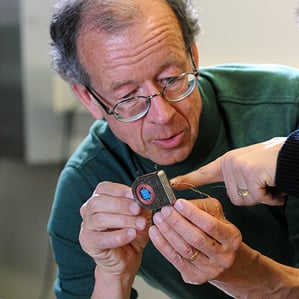A Wireless Brain-Computer Interface
A new wireless brain implant could be an important step toward technology that lets people with mobility problems control a computer or wheelchair with their thoughts.

The implant was developed by a team at Brown University in Providence, Rhode Island. The researchers recently reported in the Journal of Neural Engineering that their fully implantable brain sensor can record the activity of dozens of neurons in freely moving subjects. And they showed that the device continued to work after more than a year in pigs and macaques.
The next goal for the team is to test the device in humans. The promise of brain sensors that help paralyzed people regain some mobility is slowly being realized: last year, two groups reported that quadriplegic volunteers had used brain implants to control robotic arms (see “Brain Chip Helps Quadriplegics Move Robotic Arms with Their Thoughts” and “Patient Shows New Dexterity with a Mind-Controlled Robot Arm”).
“We are trying to develop devices to connect the brain back again to the outside world or to the body,” says John Donoghue, a neuroscientist at Brown, who led one of the projects involving quadriplegics but was not involved with the new work. “Currently, this is set up with a plug in the head through a hole in the skin,” he says. This is cumbersome and introduces the risk of infection. Furthermore, it requires a technician to hook the patient up to the external equipment. If these kinds of systems are to become available to paralyzed people in their homes (still a far-off prospect), then a fully implanted, wireless device will be needed, says Donoghue.
But it is challenging to make a device that is small enough to be implanted and yet powerful enough to send the large volumes of data collected in the brain over a wireless connection, says Arto Nurmikko, an electrical and neuro-engineer at Brown and the senior author on the study.
Nurmikko and his team had to pack a battery, a copper coil for recharging, a wireless radio and infrared transmitters, and custom-designed signal-processing chips into a small, leak-proof, body-friendly container. The titanium can that holds all these components is a little more than two inches long and is designed to sit above the skull but below the skin. A 100-electrode neuron-reading chip is implanted directly into the brain and sends the information it records through fine wires to the rest of the gadgetry. The device, which can transmit the data wirelessly, can be recharged through the skin by inductive coupling, similar to the system used in many electric toothbrushes.
The researchers tested the device in two pigs and two macaques, recording the activity of the brain regions with the implants about once per week for a year. Over the year, the performance of the electrodes diminished, which is consistent with previous reports on the longevity of the recording devices. But the researchers could not detect any electronic leakage from the titanium case.
The wireless signals emitted by the device were detected by a nearby receiver. “The strategy here is to have the subject or future patient a few meters away from the electronics that contain the receivers and means of decoding the full language of the brain circuitry that you are monitoring,” says Nurmikko. He says the device can wirelessly transmit up to tens of megabits of data per second.
Before this device can be used in people, it will have to undergo safety testing and earn regulatory approval both for its electrical elements and for the materials that touch the body. In the meantime, the technology could help neuroscientists better study brain activity and related behavior in freely moving lab animals. “This opens up a very interesting way to naturalistically study brain circuits that has not been available before,” says Nurmikko.
Keep Reading
Most Popular
Large language models can do jaw-dropping things. But nobody knows exactly why.
And that's a problem. Figuring it out is one of the biggest scientific puzzles of our time and a crucial step towards controlling more powerful future models.
The problem with plug-in hybrids? Their drivers.
Plug-in hybrids are often sold as a transition to EVs, but new data from Europe shows we’re still underestimating the emissions they produce.
How scientists traced a mysterious covid case back to six toilets
When wastewater surveillance turns into a hunt for a single infected individual, the ethics get tricky.
Google DeepMind’s new generative model makes Super Mario–like games from scratch
Genie learns how to control games by watching hours and hours of video. It could help train next-gen robots too.
Stay connected
Get the latest updates from
MIT Technology Review
Discover special offers, top stories, upcoming events, and more.